.
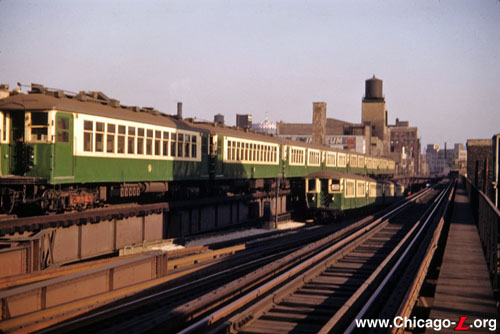
Two trains of 4000-series cars meet near Evergreen Junction, looking southeast on October 11, 1952. The train on the right, led by a "Baldie" 4000, is a Logan Square train emerging from the Milwaukee-Dearborn Subway. The train on the left may is an equipment transfer; the elevated tracks south of here -- the Paulina Connector -- were no longer used in revenue service at this point. Evergreen Junction, where the old Milwaukee Elevated, the portion later dubbed the Paulina Connector, and the Dearborn Subway, is behind the photographer. 4000s replaced the 6000s on the Milwaukee service around this time. For a larger view, click here. (Photo by George Krambles, courtesy of the Krambles-Peterson Archive) |
Evergreen
Junction
Evergreen Avenue and
Milwaukee Avenue, Wicker Park/Noble Square (West
Town)
Service
Notes:
|
Services:
|

|
Paulina
Connector/Milwaukee Elevated/Milwaukee-Dearborn Subway
|
Quick Facts:
Established: February 25,
1951
Original Line: Paulina Connector & Milwaukee
Elevated
Rebuilt: n/a
Status: Demolished
Profile:
On February 25, 1951, the Milwaukee-Dearborn
Subway opened, connecting the Logan
Square branch with downtown more directly. At this point, the
north-south section of the old Northwest branch became nonrevenue
trackage known as the Paulina
Connector. A connection between the Milwaukee
Elevated and Paulina
Connector remained at Evergreen Avenue for several years, as the
connector was the only connection between the Milwaukee
Elevated (as the newly-independent portion of the Northwest
branch along Milwaukee Avenue became known) and the rest of the
system and was used for nonrevenue equipment moves.
The switches at Evergreen Junction were all hand-throw, owing to its relatively infrequent use and lack of any scheduled revenue service that required frequent switching of trains -- other than occasional equipment transfers, work trains, charters, and the like, all trains ran between the Milwaukee
Elevated and the Milwaukee-Dearborn
Subway. There was a home signal, a single-arm semaphore, at Evergreen on
the approach to the subway, but since these were hand-throw
switches the signal was probably just rodded to the switch stand. This low-key utilization was not always to be the case, however. Originally, a more robust use was envisioned for Evergreen Junction.
During the planning for the Initial System of Subways in the 1940s, the intent of constructing the Milwaukee-Dearborn Subway wasn't to replace the portion of the Northwest Branch along Paulina Street -- the Paulina Connector -- but to supplement it. Although the purpose of the Milwaukee-Dearborn Subway was to provide a more direct route for trains from the Northwest Side to Downtown, the City intended to continue using the old Paulina trackage. Indeed, in later stages of the Comprehensive Plan for the Extension of the Subway System, plans called for building a line roughly parallel to Paulina or Ashland north from Milwaukee to meet the Ravenswood branch, and south along the same alignment between 21st Street on the Douglas branch and Ashland/79th, in essence creating a crosstown line via the Paulina Connector.
Aside from these grander, long-term plans, circa 1946 (before the CTA assumed operation of the system),
there was a more immediate concept to operate half of the Logan Square trains over
the old elevated alignment via Paulina and the Met main line (to the Loop or to Wells Street Terminal) and operate half via
the subway, and likewise to operate half of the Humboldt Park trains over the elevated and half via the subway. To that end, the plans for the Milwaukee-Dearborn Subway included a new tower north of Damen station, a few blocks northwest of Evergreen Junction. The plan was to have the new Damen Tower control both Damen Junction and Evergreen Junction.. By situating the new tower between the two junctions, the towerman could have a view of both locations, aiding in his simultaneous control of both interlocking plants.
After the CTA took over and began to prune and reorganize the rail system, they had other plans for how to route trains via the Milwaukee-Dearborn Subway versus the old Northwest branch along Paulina. When the subway opened in 1951, only trains from Logan Square used the new subway, leaving no trains using the old elevated connection via Paulina. The new Damen Tower, however, was still built. But, while the structure of the new tower was erected, it was never equipped or functioned as a tower -- it never had an tower panel or any of the associated gear or infrastructure. (See the Damen Tower page for more history of and information about this tower.)
In the years after the Congress
Line opened, very few trains used the portion of the Paulina
Connector north of Lake Street. A couple of charters and fan trips used it,
and a work train or two every now and then. Finally, in August 1964,
it was decided to remove the portion of the Paulina
Connector between Washington
Junction and Evergreen Junction from service in preparation for
demolition. Evergreen Junction was removed from service at that time.
Actual demolition may not have occurred until about 1968. The
switches were replaced with straight rails.
Today, only a few cutoff
bents encased in the concrete walls along side the descent into the Milwaukee-Dearborn Subway
belay the previous existence of the elevated line that once connected
overhead.
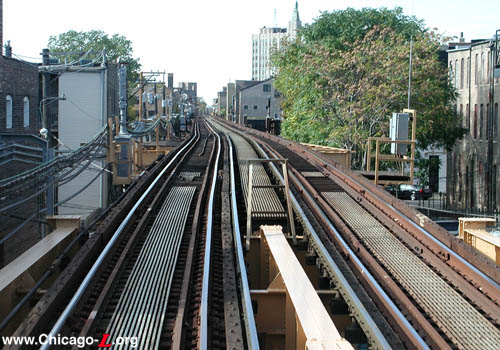
The former location of Evergreen Junction is seen looking northwest on the Blue Line's Milwaukee Elevated from near Wolcott Street on October 13, 2003. A few remnants provides telltale signs of the former elevated branch that diverged here. Note the bits of structure that flair out just beyond the equipment and signal cantilevers -- these are remaining bits of elevated structure for the former Paulina Connector tracks that diverged off here. For a larger view, click here. (Photo by Graham Garfield) |

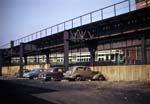 |
ROW@EvergreenPortal01.jpg (181k)
A train of flat-door 6000-series cars heads down into the Milwaukee-Dearborn Subway from the Milwaukee
Elevated on February 24, 1951, while the original Northwest branch elevated line to downtown (later called the Paulina
Connector) looms overhead. Evergreen Junction, where the subway and elevated connected, was a few hundred feet to the left out of frame. The front sign on the car reads "Special" -- they were probably operating demonstration trips for the public since the subway didn't open for revenue service until the next day. (Photo by Henry M. Stange, courtesy of the Krambles-Peterson Archive) |
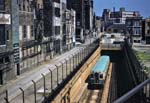
|
ROW@EvergreenPortal02.jpg (282k)
A Congress-Milwaukee "A" train of 6000-series cars is seen emerging from Evergreen Portal, the north end of the Milwaukee-Dearborn Subway, from a vantage point up above on the Paulina
Connector on July 15, 1960. The railing along the side of the elevated connector track is visible in the right lower foreground. (Photo by George Krambles, courtesy of the Krambles-Peterson Archive) |
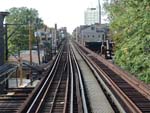 |
ROW@Evergreen01.jpg (278k)
The former location of Evergreen Junction is seen looking northwest on the Blue Line's Milwaukee Elevated on October 13, 2003. The switches were located in the foreground of the view, before the wayside block signal on the right. (Photo by Graham Garfield) |
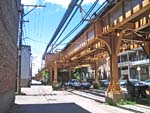
|
ROW@Wolcott01.jpg (203k)
The former location where the Milwaukee-Dearborn Subway joined the old Northwest Branch of the Metropolitan Division elevated is seen from street level, taken looking northwest from Wolcott in June 2005. Note the sections
of structure that flare out and then end abruptly: these are the remnants of the connection that was built to link the Northwest Branch south of Evergreen (the Paulina
Connector) to the portion north of Evergreen (the Milwaukee
Elevated) after the subway was built and linked into the Milwaukee
Elevated. (Photo by Tony Coppoletta) |








